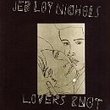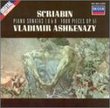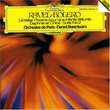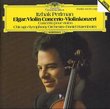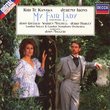| All Artists: Dohnanyi, Falletta, Royal Scottish National Orchestra, Ludwig Title: Dohnányi: Violin Concerto Nos. 1 and 2 Members Wishing: 0 Total Copies: 0 Label: Naxos Original Release Date: 1/1/2008 Re-Release Date: 4/29/2008 Genre: Classical Styles: Forms & Genres, Concertos, Instruments, Strings, Symphonies Number of Discs: 1 SwapaCD Credits: 1 UPC: 747313083374 |
Search - Dohnanyi, Falletta, Royal Scottish National Orchestra :: Dohnányi: Violin Concerto Nos. 1 and 2
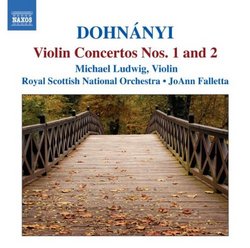 | Dohnanyi, Falletta, Royal Scottish National Orchestra Dohnányi: Violin Concerto Nos. 1 and 2 Genre: Classical
|
Larger Image |
CD DetailsSimilarly Requested CDs
|
CD ReviewsTwo Necessary Violin Concertos J Scott Morrison | Middlebury VT, USA | 08/26/2008 (5 out of 5 stars) "Ernö von Dohnányi (1877-1960) was roughly contemporary with two other renowned Hungarian composers -- Bartók and Kodály -- but unlike his more adventurous countrymen he never strayed too far from the late 19th-century German musical tradition in his compositions. His two violin concertos are very much in the same vein as those by Brahms, Goldmark, Korngold and Joachim. Strangely, although they are marvelously crafted and completely accessible works, they are rarely heard in concert. It is wonderful, then, that Naxos has issued a release with terrific fiddling by Michael Ludwig and rock-solid support from JoAnn Falletta and the Royal Scottish National Orchestra. Both concertos are unusually in four movements. The first was written in 1915 while Dohnányi was teaching at the Berlin Musikhochschule. Of the two concerti it is the more Brahmsian in both its construction and its sound-world. It is filled with drama and lyricism. The first movement has a long and portentous orchestral introduction leading to an opening cadenza by the solo violin that evolves into a lyrical section before the introductory material returns and is developed, intertwined with virtuosic display by the soloist. The second movement is both lush and ecstatic. The orchestration of the opening moments is particularly effective with bassoons and low strings. The violinist's delicate entry from upon high is ravishing. Ludwig makes the most of this. The vivace third movement flashes by -- interrupted only by a gorgeous lyrical middle section -- with glinting double-stops reminiscent at times of Gypsy fiddling. An extremely virtuosic recomposition and extension of the opening cadenza leads us into the finale with its Brahmsian 'big tune' which is then treated to a set of variations, some delicate, some fiery, all containing scintillating things for the violinist to do. A short cadenza ushers in a return of the first movement's main theme and then after yet another cadenza there is a triumphant conclusion. Thirty-four years passed before Dohnányi composed another violin concerto. It was written in 1949 where Dohnányi finished his life as a beloved teacher at Florida State University. It opens with a brief orchestral shout followed by a dramatic cadenza that becomes more and more lyrical. Contrapuntal density ensues but it is leavened with what almost sounds like 1940s movie music lushness. The first movement feels episodic or perhaps narrative. The harmonic language of this concerto is a bit more 'modern' in one sense, but the orchestration itself sounds Korngoldian. The movement ends in a gently nostalgic mood. The second movement is an impish scherzo -- it dances by in less than four minutes --with its share of exotic Eastern European coloration. The Adagio is a soulful lament. The violin sings of heartbreak and healing. (This is my favorite movement of the eight. I have replayed it perhaps ten times. Ludwig plays it so beautifully that it almost brings tears to the eyes.) The finale is a heart-easing romp, buoyant and cheerful, and precisely what the concerto needs after the emotionally touching Adagio. I had never heard either of these concertos before but am thrilled to have made their acquaintance. I believe that they both deserve a place in the -- let's face it -- rather limited list of frequently played violin concertos. If I had to choose one over the other, I'd go with the Second, but frankly now that I know them I don't want to be without either of them. And I can't praise violinist Ludwig or conductor Falletta and the RSNO enough. Psst! Buy this one! Scott Morrison" Otherworldly Mark A. Fitzgerald | Pittsburgh, Pa. United States | 11/25/2008 (5 out of 5 stars) "I find this music otherworldly. It seems to come in from a different time; it's like a gentle sweeping. The two concertos almost appear in their sound images as a single vision, and have a sound that is reminiscent of Bohemian themes, but I would definitely identify as Hungarian. The first concerto is probably my favorite: there is more of a "broad" feel to it - I really like it because it's very different from the majority of music I listen to and hear (such as Mozart, Beethoven, Vaughan-Williams, Bruckner, etc.) I'd say as violin concertos these works are strong and balanced; the articulations of the violin are clear, but not overwrought. Concerto number two begins with more of a flourish and later regains the gentle sense of a clear plain or valley - it's like concerto one turned inside out. they are both interesting to listen to, and well-performed. This CD was an introduction to the composer for me, though I had heard a couple of previous pieces on classical radio. I was tired of the "usual" when I found this CD."
|

 Track Listings (8) - Disc #1
Track Listings (8) - Disc #1